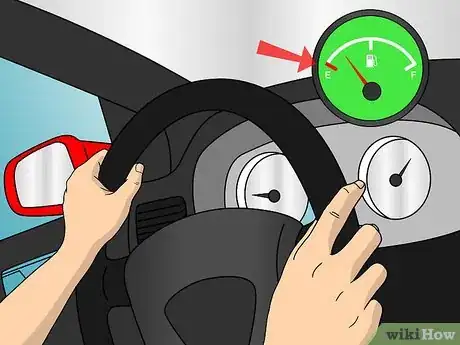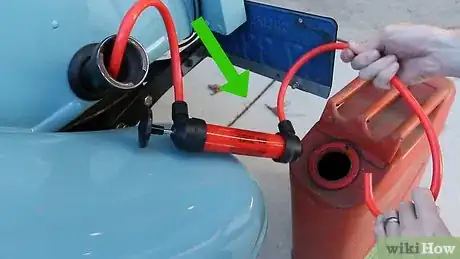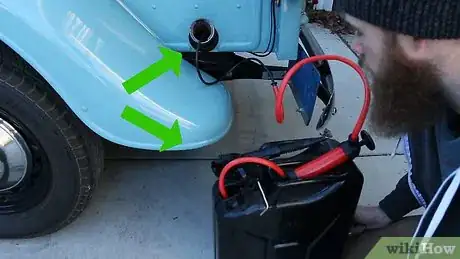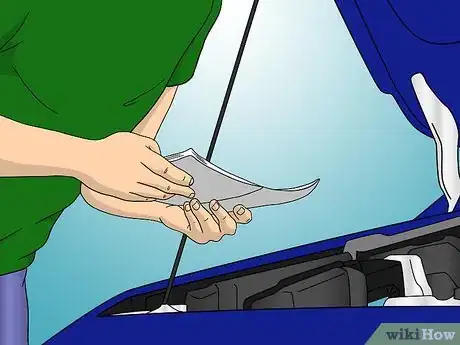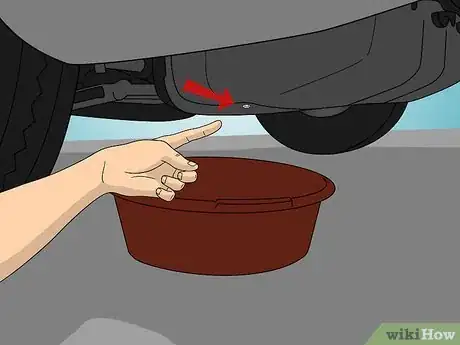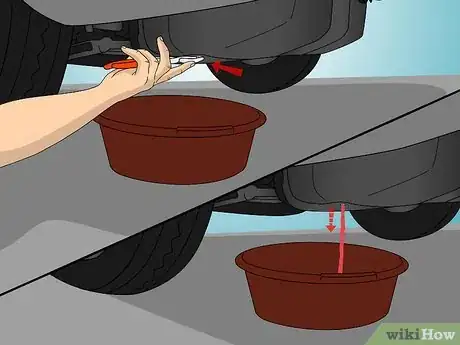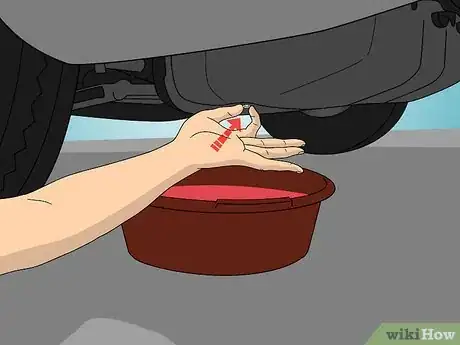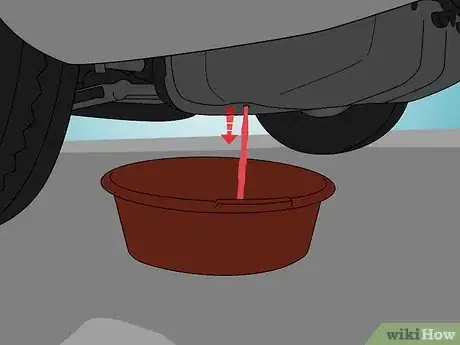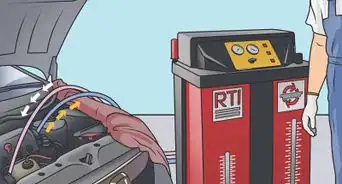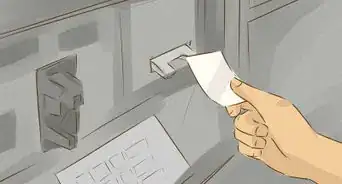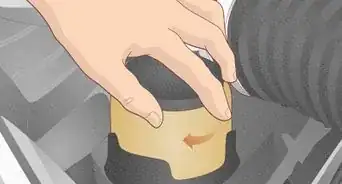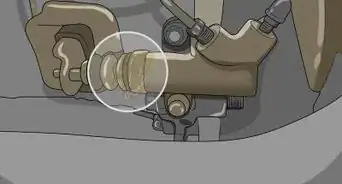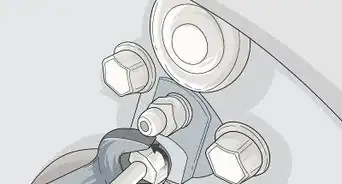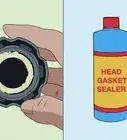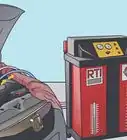This article was co-authored by Duston Maynes. Duston Maynes is an Automotive Repair Specialist at RepairSmith. Duston specializes in leading a team that handles a variety of automotive repairs including replacing spark plugs, front and rear brake pads, fuel pumps, car batteries, alternators, timing belts, and starter motors. Duston holds an Associate’s degree in Automotive/Diesel Technology from The Universal Technical Institute of Arizona and is a Certified Diagnostic Technician and Automobile Mechanics Technician through BMW STEP. RepairSmith received The 2020 Big Innovation Award by Business Intelligence Group and The Startup of the Year by the American Business Awards. RepairSmith was also included in Built in LA’s 50 Startups to Watch and The Business Intelligence Group’s 52 Names Leading the Way in Customer Service. RepairSmith offers in-home services to provide car owners convenient and complete auto repair everywhere.
This article has been viewed 864,794 times.
Draining the gas out of your car, whether because you put the wrong fuel in, because you're selling the car, or because you're making repairs, is not always easy. Every car is different, and the tank is not designed to allow the gas to leave the tank once it has entered it, since this could cause serious malfunctions or fires. That said, there are a variety of methods to try that may help you empty your tank.
Things You Should Know
- Stick a fuel siphon system's hose into the gas tank and pump until you've filled your tank with gas.
- Place a pan underneath your drainage plug and then, unscrew the drainage plug. Gas will flow out and usually takes several minutes per gallon.
- Drain your tank if you loaded the wrong fuel or you need to replace your fuel pump.
Steps
Siphoning Your Gas
-
1Run the car close to empty, if possible. Unless you have the wrong fuel in the tank, turn the car on and run the gas down towards empty by driving around. Park the car and let it cool before beginning to drain it.
- This strategy will decrease the amount of pumping and draining you have to do, and leaves you with less gas to store or dispose of.
- Never run a car if you have the wrong fuel in the tank. Draining a full tank will take a long time, but it is not impossible.
-
2Purchase a fuel siphon system. Sold at most auto stores, these are manually operated pumps that will draw the gas out of your car and into a container. Make sure that you buy one that is approved for combustible materials, as any sparks near your gas tank are a sure recipe for disaster.
- You'll need six feet or so of small ⅜ inch hose, as well as a pump to draw the fuel out.
- The old trick of sticking a hose in the gas tank then sucking out the gas with your mouth is hazardous to your health and incredibly dangerous. You could swallow gasoline or spill enough to create a serious fire hazard.
- Have a fire extinguisher specifically for gas fires nearby in case of a fire.
- Some vehicles have saddle-type fuel tanks and may require a specialized way of removing the fuel from both sides of the tanks. Seek a professional's help or advice to get all the fuel out.
Advertisement -
3Stick your hose into the gas tank, feeding it until there is only one to two feet left before the pump. This is the hardest part of process, as newer cars sometimes have protective metal bulbs or screens that prevent gas from escaping the car in case of a crash. For older cars you should be able to get the hose right in the tank without hindrance, but you'll need a new strategy for newer models:
- Take a separate, smaller tube that is rigid and resists kinking.
- Force this tube down until it hits the blockage, then twist, push, and force the tube around the metal bulb blocking entry to the tank. If a reasonable amount of force doesn't succeed, do not continue, as you may puncture the filler tube or cause other damage.
- Take your larger tube, the one connected to the pump, and slip it over the smaller tube.
-
4Pump your hand pump until gas comes out. As you pump, have your receptacle for gas ready to be filled up. Hold onto the end of the hose, as it can start to move when the gas begins to flow.[1]
- If you don't have a pump, but you have a spare tube, stick that in as well. Then, blow into this spare tube, pushing air into the tank, which will then force the gas out of your other tube.
-
5Remove the tube and refill the tank. Your tank is empty, and you're ready to move on with your repairs. If you are working on a gasoline or diesel vehicle that had the wrong fuel put in the tank, you may have to flush out the fuel tank and fuel system with the correct fuel.
-
6Reuse the gas, or dispose of it properly. If the gas is not old or unusable you can put it in another car or gasoline engine. If you need to get rid of it you should contact your local environmental waste disposal center. Never pour gas down a drain or sewer. You can often call your local fire department for information on how to dispose of environmental waste safely and effectively.
- Check the Yellow Pages under Environmental and Ecological Services and Oils, Waste.
- If you plan on reusing the fuel after the repairs are done, make sure you are storing the fuel in approved fuel containers.
- You may have to pay to dispose of the gas.
Draining the Gas With the Fuel Pump
-
1Know that not all fuel tanks can be drained directly. This is a model by model fix, but it should work for most cars. If you can find your fuel tank while underneath the car, and you can detach the lines and/or small drain plug directly, this is the easiest way to drain the car.
- Some vehicles have a fuel test port under the hood to which a fuel tester can be attached and drain the fuel with the special tool. This will require turning on the fuel pump while the engine is not running by jumping the fuel pump relay or using a scan tool.
-
2Place a pan or receptacle underneath the drainage plug. If you have several gallons of gas left in the tank, you need to be prepared to catch it. This is easier said than done, so try and gauge how much gas is in the tank before beginning and have the appropriate number of containers on hand before starting.
- It is very, very hard to plug the tank back up while it is draining, so don't plan on stopping until the job is done.
-
3Get under the car and find the drainage plug. The fuel tank is a large, solid metal container on the same side of your car as you fill up gas on. Use your gas door as a gauge -- it is usually underneath the passenger-side seat. Make sure your pan is directly under the plug.
- This plug is simply a small bolt screwed directly into the tank. Opening it simply creates a hole for gas to drain out. You usually need a spanner or socket wrench to remove it. However, not all vehicles will have this drain plug.
- If you see the fuel lines, which are small, removable hoses underneath the tank, you can use these as well. However, you must turn the car on and off, repeatedly, to force the gas out of the tank, as it uses the electric fuel pump to to all the work.
-
4Unscrew the drain plug and let the fuel drain. This will take a long time, up to several minutes per gallon, so you should keep an eye on it.
- Make sure to have more than enough drain pans to catch all the drained fuel and to make sure no fuel is spilled onto the ground.
-
5Replace the drain plug tightly and refill your car. Take care to get the plug hooked up again properly, especially if you disconnected the fuel lines. Once everything is hooked back up, you're good to go.
Knowing When To Drain The Tank
-
1Never drive with the wrong fuel type in the engine. The most common mistake is to fill a car with diesel when it needs to run unleaded or filling a diesel vehicle with gasoline. The improper fuel can do serious damage to your engine, and can even total the car if you're not careful. Make sure you not only drain the fuel tank of the wrong fuel, but to flush out the fuel lines and replace the fuel filters.
-
2Drain and replace the fuel on any car that's been sitting for more than six months to a year. Fuel can, and will, go bad when it is just sitting in a tank. If you're thinking of dusting off the old car in the garage for a spin, make sure you drain and replace the gas to ensure that everything runs smoothly. This is equally important if you're trying to fix a car up or work on it's engine.
- The introduction of ethanol into the gas supply has greatly reduced the life-span of gasoline. It degrades much faster, meaning you need to be extra vigilant about draining the fuel if the car hasn't run in a long time.[2]
-
3Drain the gas if you need to replace the fuel pump. You can't proceed with the repair if there is still gas in the tank, so be sure to take you time draining it before beginning.
- You must also drain the gas to replace the fuel gauge sending unit.
Expert Q&A
-
QuestionHow can you tell if you need to change your fuel filter?
 Duston MaynesDuston Maynes is an Automotive Repair Specialist at RepairSmith. Duston specializes in leading a team that handles a variety of automotive repairs including replacing spark plugs, front and rear brake pads, fuel pumps, car batteries, alternators, timing belts, and starter motors. Duston holds an Associate’s degree in Automotive/Diesel Technology from The Universal Technical Institute of Arizona and is a Certified Diagnostic Technician and Automobile Mechanics Technician through BMW STEP. RepairSmith received The 2020 Big Innovation Award by Business Intelligence Group and The Startup of the Year by the American Business Awards. RepairSmith was also included in Built in LA’s 50 Startups to Watch and The Business Intelligence Group’s 52 Names Leading the Way in Customer Service. RepairSmith offers in-home services to provide car owners convenient and complete auto repair everywhere.
Duston MaynesDuston Maynes is an Automotive Repair Specialist at RepairSmith. Duston specializes in leading a team that handles a variety of automotive repairs including replacing spark plugs, front and rear brake pads, fuel pumps, car batteries, alternators, timing belts, and starter motors. Duston holds an Associate’s degree in Automotive/Diesel Technology from The Universal Technical Institute of Arizona and is a Certified Diagnostic Technician and Automobile Mechanics Technician through BMW STEP. RepairSmith received The 2020 Big Innovation Award by Business Intelligence Group and The Startup of the Year by the American Business Awards. RepairSmith was also included in Built in LA’s 50 Startups to Watch and The Business Intelligence Group’s 52 Names Leading the Way in Customer Service. RepairSmith offers in-home services to provide car owners convenient and complete auto repair everywhere.
Automotive Repair Specialist Refer to your car's owner manual to see when it would be due for service. Some manufacturers have the fuel filter built into the fuel pump assembly; in those cases, you'll need a trained technician to perform the work.
Refer to your car's owner manual to see when it would be due for service. Some manufacturers have the fuel filter built into the fuel pump assembly; in those cases, you'll need a trained technician to perform the work. -
QuestionWhat do I do if someone pours oil into my gas tank?
 Community AnswerDrain the fuel and flush the tank with more fuel. A little oil isn't going to hurt anything, but a lot of oil can screw up the flow of fuel, causing damage to points, plugs, spider injection systems, and can even catch fire if not properly handled.
Community AnswerDrain the fuel and flush the tank with more fuel. A little oil isn't going to hurt anything, but a lot of oil can screw up the flow of fuel, causing damage to points, plugs, spider injection systems, and can even catch fire if not properly handled. -
QuestionIs it dangerous to hit the top nut on the fuel pump with a screwdriver and a hammer?
 Community AnswerYes. A spark too small for you to see can ignite fumes.You should use a brass rod or brass punch instead of a screwdriver.
Community AnswerYes. A spark too small for you to see can ignite fumes.You should use a brass rod or brass punch instead of a screwdriver.
Warnings
- Be careful not to over pressurize the tank, a quick blast from an air hose and then see how much comes out.⧼thumbs_response⧽
- Always have a fire extinguisher nearby.⧼thumbs_response⧽
- Watch out for fumes. Any spark, lit cigarette, etc. could result in an explosion.⧼thumbs_response⧽
- Remember that gasoline fumes can be very volatile and hazardous to your health.⧼thumbs_response⧽
- Be careful when you release the pressure to the tank, or you can get fuel blown out the wrong way.⧼thumbs_response⧽
- Be careful not to spill as fuel is toxic.⧼thumbs_response⧽
References
About This Article
To drain the gas tank of your car, start by placing a large pan under the drainage plug, or the small bolt screwed directly into the gas tank. Then, remove the plug with spanners or a socket wrench, and let the fuel drain into the pan. Make sure to keep an eye on the fuel as it drains to ensure that it doesn’t spill onto the ground. Once the gas tank is empty, replace the drainage plug and refill your car with gas. To learn more, including how drain your gas tank using a siphon pump, read on.
